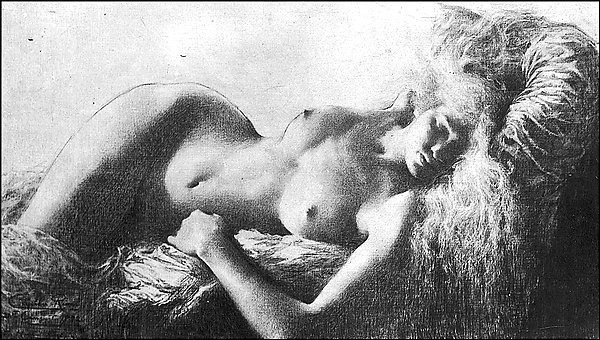Oh Baby, When I look in Your Eyes I Go Crazy
Amelie Rives, Princess Troubetzkoy
Artist: Pierre Troubetzkoy (American (born Russia), 1864–1936)
Printer: Alvin Langdon Coburn (British, Boston, Massachusetts 1882–1966 Wales)
Date: 1904
Alfred Stieglitz Collection, 1933
Metropolitan Museum of Art
One of the benefits of being obsessed with old family stories is just that, many old family stories. My grandmother is from an ancient Virginia family and often discussed cousins, aunts, and great-great grandparents in polite and obscure language. "Well," she would say, in a languid Virginia drawl, "she was a true beauty and quite eccentric." And that would be that.
For example, my grandmother's cousin Amelie Rives' was the granddaughter of Senator William Cabell Rives. Her godfather was General Robert E. Lee. She was named after a great aunt, Amelie Rives Sigourney, a goddaughter of French Queen Marie-Amélie. Sigourney perished with her husband Henry and children at sea aboard the Ville du Havre in 1873. She was born at the end of the civil war and lived at Castle Hill, built by one of my distant grandfathers Dr. Thomas Walker, near Charlottesville.
Amelie wrote novels and plays, including the shocking The Quick and the Dead?. The protagonist was a newly widowed woman struggling with erotic passion for her late husband's cousin. The book was reviewed as "immoral," "unfit to be read," and "impure." In 1888, she married John Armstrong "Archie" Chanler. His parents were John Winthrop Chanler and Margaret Astor Ward, and he was the grandson of John Jacob Astor.
The marriage was a disaster, with details including morphine addiction in France, affairs, and eventual madness. The Chanler and Astor families claimed that Amelie drove Archie mad. This claim, based on my experience in my family, is entirely possible and rather probable. Donna M. Lucey's engaging and enormously kind biography, Archie and Amelie, Love and Madness in the Gilded Age, retells the story.
After the divorce, Archie explored the paranormal insisting that he could put himself into a trance in which his face would become Napoleon's death mask. In 1897, Archie's family institutionalized him at the Bloomingdale Insane Asylum. Their motives may have been more financial than based on mental illness.
Amelie became the toast of European society and married Russian Prince Pierre Troubetzkoy. Troubetzkoy was "an artist and an aristocrat" who was extraordinarily handsome but had no money. The two settled at Castle Hill for the rest of their lives.
Eccentric and seemingly unwilling to join the actual world, Amelie and the Prince wandered the estate as if in a Southern gothic novel. I imagine days of lethargy and melancholy as a misunderstood artist. My grandmother once said she was grotesquely sensitive.
Archie was a true gentleman. He moved to Charlottesville and supported Amelie and the prince financially his entire life. In 1909, a neighbor's wife fled to Chanler's house from frequent domestic abuse. Her husband attacked and accidentally shot and killed him during a struggle. Neighbors whispered that one of Archie's friends, a local African American man, defended the woman and shot her husband. Recognizing the apparent outcome and racial injustices, Chanler claimed he shot the man.
In 1891 he established the Paris Prize Fund, which enabled select students to study art abroad. He left enormous funds to the University of Virginia and University of North Carolina. He also endowed a research fellowship at the Mackay School of Mines, a division of the engineering school at the University of Nevada.
This entire story was never discussed and was somehow distilled by my grandmother, who said, "Amelie? Why, she was such a fine beauty."
Hell per a Spirit-Message There from a Study in Graphic-Automatism, John Armstrong Chanler,
Castle Hill, Virginia











